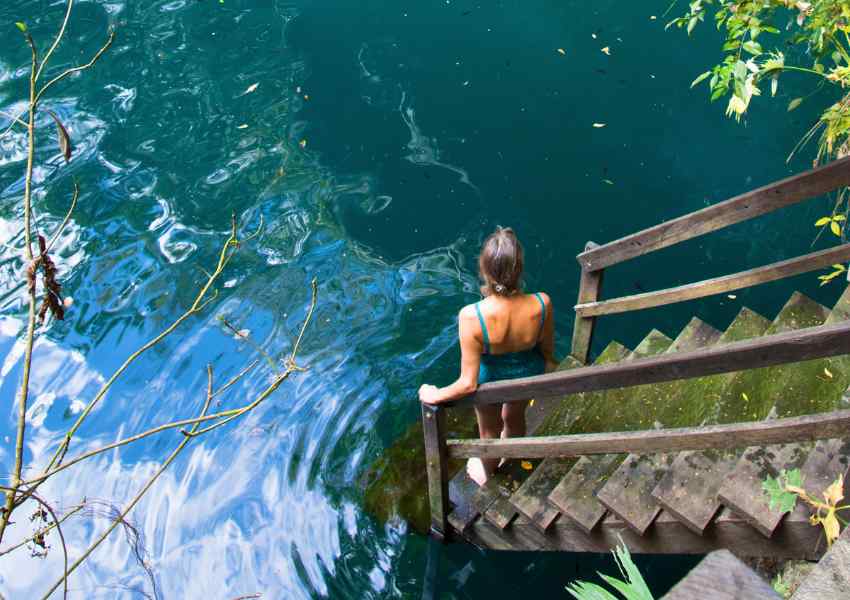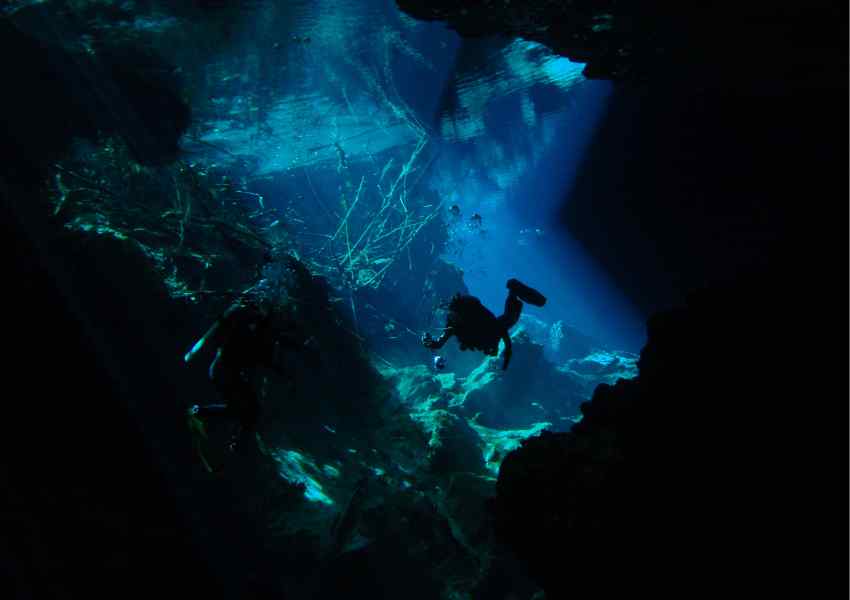Are Cenotes Safe? What You Need to Know Before Diving in Mexico’s Natural Sinkholes
Are cenotes safe? is a question that pops to mind to most travelers in the Yucatan Peninsula.
Visiting them is a one-of-a-kind experience, but if you’re worried about safety, here’s everything you should know!
These natural sinkholes, filled with crystal-clear freshwater, offer an unparalleled experience for adventurers and nature lovers alike.

However, the allure of cenotes also brings up important questions about safety. Are cenotes safe to explore? What precautions should you take before diving into these mesmerizing underwater caves?
In this post, we will delve into the essentials of cenote safety, providing you with the knowledge you need to enjoy these magical sites responsibly and confidently.
Understanding Cenotes
Cenotes are natural sinkholes that reveal the rich complexity of the Earth’s geology.
Known for their crystal-clear waters, these formations have cultural and scientific significance.
What Are Cenotes?
Cenotes are unique natural phenomena found primarily in Mexico’s Yucatán Peninsula. They are natural sinkholes formed by the collapse of limestone bedrock, which exposes groundwater below.
These openings create stunning geological features often linked by underground cave systems.
For centuries, cenotes have held cultural importance, especially to the Maya civilization, which regarded them as sacred water sources and portals to the underworld.

The Formation of Cenotes
The process that leads to the creation of cenotes is fascinating.
It begins when rainwater, slightly acidic from absorbing carbon dioxide, seeps through limestone, gradually dissolving it.
Over time, underground caves and cavities form. When the cave ceilings collapse, the water-filled sinkholes we call cenotes are revealed.
Limestone rich areas like the Yucatán Peninsula provide the perfect setting for these natural wonders to form.
Changes in sea levels and geological activity over millennia have contributed to their current shapes and sizes.
Types of Cenotes
Cenotes come in several types, each with distinct characteristics.
Open cenotes are exposed at the surface and resemble ponds or lakes.

Semi-open cenotes have partially collapsed roofs, allowing sunlight to penetrate the water.
Closed cenotes are fully beneath the surface, often accessible only through cave entrances.

Each type offers a unique experience, with varied lighting, water conditions, and ecosystems to explore.
Travel Insurance for Mexico
Make sure you get travel insurance for your trip to Mexico to avoid any emergencies or extra costs!
We love using Safety Wing as it starts at just a couple of dollars per day and will have you covered when it comes to medical emergencies, lost luggage, delays, and more.
Are Cenotes Safe?
Water Quality and Health Risks
You’re going to want to know about the water quality because it drastically impacts your experience.
Cenotes can harbor bacteria and other pathogens, especially E. coli and amoebas. Contamination can occur from nearby development or improper waste disposal.
To avoid getting sick, make sure to check for any local water advisories before taking a dip.
Using eco-friendly sunscreen helps protect you and the environment. Some cenotes have regulations against wearing sunscreen due to its potential to harm aquatic life.
Always shower before entering, freeing your body of oils and lotions, which preserves the ecosystem’s delicate balance.

Physical Risks While Exploring
Cenotes come with their share of physical challenges.
With uneven terrain, submerged rocks, and slippery surfaces, footing can be tricky, so walk slowly and bring shoes with a good grip! This is my biggest worry when I visit cenotes, honestly.
Plus, since they’re underground, most cenotes have wooden stairs to help you reach the bottom. These can be super slippery as wet people walk up and down. Be super careful here since slipping is easy!
Watch out for low ceilings in underwater caves, which require you to be mindful of your headwear.
Diving into cenotes? Ensure you’re experienced or accompanied by a pro. Cenotes can be deep, with hidden currents making swimming harder than expected. You’ll also need a diving license.
Always wear a life vest if you’re not a strong swimmer.

How to Prepare for a Safe Cenote Visit
Before you explore a cenote, make sure you’re prepared with the right gear and understand the rules.
What to Bring
- Swimming gear is a must—think swimsuit, goggles, and a snorkel if you’re keen on underwater views. Many companies offer gear, but I prefer to bring my own. I love this mask from Amazon for snorkeling!
- Biodegradable sunscreen is crucial to protect the delicate ecosystems. Regular sunscreen can harm aquatic life, so ensure your choice is eco-friendly. Raw Love is my favorite kind and this bundle is great because it includes body and face reef-safe sunscreen as well as lip balm.
- Consider bringing a dry bag like this one to keep your belongings safe from water exposure.
- Swimming shoes like these are also a good ideas they’ll protect you from rocks and have a good grip.
- If you’re planning photos, get a waterproof camera or case for your phone (this one is great).
- A basic first-aid kit is always a good idea!

Rules and Regulations
- Always shower before entering the cenote to minimize oils or chemicals entering the water. It’s often required, not just suggested.
- Some cenotes have specific no-touch policies to preserve natural formations and wildlife.
- Follow posted signs and respect any guidance from local staff or guides regarding swimming zones and depths.
- It’s essential for personal safety to stay within designated areas, especially since cenotes can have unique underground currents.
Swimming and Snorkeling in Cenotes
Swimming and snorkeling in cenotes offer unique experiences.
To ensure a safe and enjoyable adventure, consider exploring these natural pools with experienced guides and keep essential tips for beginners in mind.
Guided Tours
If you’re still worried if cenotes are safe, joining a guided tour is a smart way to explore cenotes safely.
These tours are led by knowledgeable locals who are familiar with the geography and potential hazards of cenotes.
Guides help you navigate safe swimming areas and provide insights into the history and ecology of these magical places.
Guided tours cater to all skill levels, so even if you’re not an expert swimmer, there’s an option for you.
You also might have the opportunity to see unique wildlife and stunning rock formations with someone who knows where to look.

Tips for Beginners
- Always wear a life vest, as cenotes can be unexpectedly deep. Pay attention to your guide’s instructions and don’t stray from designated swimming areas.
- Bring along a waterproof bag ike this one for essentials like your phone and extra clothes.
- Swimming shoes are a great idea as they can provide good traction on slippery rocks.
- Take it slow and steady, getting comfortable with your surroundings before diving in.
- Bring your own snorkeling equipment. Most tours include them, but I prefer to bring my own since I can’t be sure if they wash them properly. I love this mask from Amazon for snorkeling!
- Many cenotes are close to interesting attractions like Mayan ruins so plan your route well and you can visit several spots during your adventure!
- Book a tour to visit cenotes in the safest way! You can visit many on your own, but if it’s your first time, a tour may be a great idea for peace of mind.
- Make sure you have travel insurance! I consider cenotes to be pretty safe, but insurance is never not a good idea. I love Safety Wing as it’s very affordable and they cover everything from medical emergencies to delays and more. Check rates and buy your travel insurance here.

Emergency Situations in Cenotes
Knowing how to handle emergencies when visiting cenotes can enhance your safety and ensure a quick response.
How to Recognize Danger
Cenotes can sometimes have hidden risks.
Watch out for sudden changes in water clarity; this might indicate strong undercurrents or a shift in weather conditions.
Keep an eye on any warning signs posted around the cenote, which often provide crucial safety information.
- Temperature Drops: A sudden drop could signal cold water currents.
- Wildlife: Be wary of unexpected encounters with wildlife such as snakes or insects.
- Structural Integrity: Watch for loose rocks or unstable platforms around the edges, which could pose a risk for falls.

Emergency Response and First Aid
In case of emergencies, it’s good to have a plan. Familiarize yourself with the location of the nearest first aid equipment before exploring a cenote.
If someone is hurt, assess the situation and call for help. Most cenotes are in remote areas, so it’s crucial to act fast.
For minor injuries like cuts or scrapes, make sure to pack a basic first-aid kit (I love this one from Amazon as it’s small and easy to carry). This should include bandages, antiseptic wipes, and pain relievers. Address any injury quickly to prevent infection.
CPR Skills: Knowing CPR can be life-saving. Consider taking a course before your trip. Still, there are usually lifeguards at cenotes.
So… Are Cenotes Safe? Should I Go?
While this post focuses on the potential dangers of cenotes, that shouldn’t scare you or stop you from visiting!
I consider cenotes safer than swimming in the ocean or even a lake, and the ones that are open for visitors are usually very safe.
Lifeguards are usually present and most tour guides know what they’re doing since they visit them often.
If you’re still worried about whether cenotes are safe or not, my recommendation would be to book a guided tour to visit them instead of doing so on your own.
This way, you’ll have someone looking out for you and your safety so you can focus on exploring these incredible natural wonders.
Travel Insurance for Mexico
Make sure you get travel insurance for your trip to Mexico to avoid any emergencies or extra costs!
We love using Safety Wing as it starts at just a couple of dollars per day and will have you covered when it comes to medical emergencies, lost luggage, delays, and more.
Conclusion: Are Cenotes Safe?
Exploring Mexico’s cenotes can be an unforgettable adventure, offering a unique glimpse into the natural beauty and geological wonders hidden beneath the surface.
Whether you’re swimming, snorkeling, or diving, being prepared and informed will allow you to fully immerse yourself in the magic of these enchanting underwater worlds.





